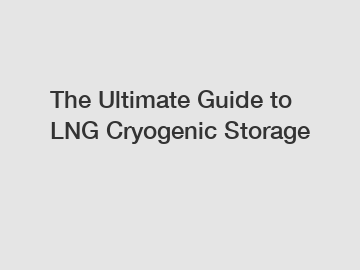Feb. 18, 2024
Machinery
What are the key components of LNG cryogenic storage? .
LNG (liquefied natural gas) has become an increasingly popular choice for energy production and transportation due to its high energy density and low environmental impact. However, the storage of LNG presents a unique set of challenges due to its cryogenic properties. In this article, we will explore the key components of LNG cryogenic storage and how they work together to ensure the safe and efficient storage of this valuable resource.
1. Insulation:

One of the most critical components of LNG cryogenic storage is insulation. LNG must be kept at extremely low temperatures (-162 degrees Celsius) to remain in its liquid state. Insulation materials such as perlite, foam glass, and aerogel are used to minimize heat transfer into the storage tank. This helps to prevent the LNG from vaporizing prematurely and ensures that it remains in a liquid state until it is ready to be used.
2. Storage Tanks:
LNG cryogenic storage tanks are typically double-walled, vacuum-insulated containers that are designed to safely store large quantities of LNG. These tanks are usually made of materials such as stainless steel or nickel alloy to withstand the extreme temperatures and pressures involved in LNG storage. The tanks are equipped with safety features such as pressure relief valves and emergency shutdown systems to prevent accidents and ensure the safe operation of the storage facility.
3. Vaporization:
When LNG is ready to be used, it must be vaporized back into its gaseous state before it can be transported or burned for energy production. This process can be achieved through the use of vaporizers, which heat the LNG to convert it into natural gas. There are several types of vaporizers available, including submerged combustion vaporizers, ambient air vaporizers, and shell-and-tube vaporizers, each with its own advantages and disadvantages.
4. Monitoring and Control Systems:
To ensure the safe and efficient operation of an LNG storage facility, it is essential to have robust monitoring and control systems in place. These systems track key parameters such as temperature, pressure, and LNG levels in the storage tanks and automatically adjust operations to maintain optimal conditions. In the event of an emergency, these systems can trigger alarms, shut down equipment, and initiate emergency procedures to prevent accidents and protect personnel and equipment.
In conclusion, LNG cryogenic storage is a complex and highly specialized process that requires careful attention to detail and adherence to strict safety protocols. By understanding the key components of LNG cryogenic storage and how they work together, operators can ensure the safe and efficient storage of LNG for energy production and transportation. The proper design, construction, and operation of LNG storage facilities are essential to minimize the risk of accidents and maximize the benefits of this valuable energy resource.
If you are looking for more details, kindly visit Cryogenic Pressure Vessel Design, bulk Cryogenic storage vessels, Low-Temperature Liquid Oxygen Micro Bulk Storage Tank.
If you are interested in sending in a Guest Blogger Submission,welcome to write for us!
All Comments ( 0 )